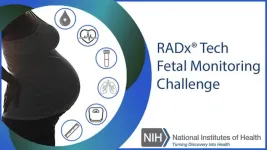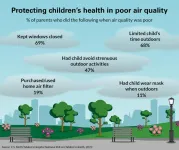Ohio State leads new global climate center on AI for biodiversity change
2023-09-18
COLUMBUS, Ohio – The Ohio State University will lead a new multimillion dollar international center devoted to using artificial intelligence to help understand climate impacts on biodiversity.
The AI and Biodiversity Change (ABC) Global Climate Center will bring together ecologists and computer scientists from six universities in the United States and Canada, with partners in UK, Europe, and Australia, to develop new AI-enabled, data-supported approaches to study how changes in climate are impacting life – including animals, plants and insects – on Earth.
$5 ...
Ohio State researchers publish national guidelines for ALS genetic testing, counseling
2023-09-18
COLUMBUS, Ohio – Researchers at The Ohio State University Wexner Medical Center and College of Medicine led the creation of evidence-based consensus guidelines for genetic testing and counseling for patients with amyotrophic lateral sclerosis (ALS), a neurodegenerative disease that affects the cells in the brain and spine.
These evidence-based, consensus guidelines provide clinicians with a framework for the offer of genetic testing and outline the information that should be provided to persons with ALS before and after testing. In addition, the guidelines provide specific recommendations regarding ...
Study: Admissions policies that consider grades and test scores in context of available opportunities are linked to college success
2023-09-18
Indicators of high school grades and standardized test scores that take into account the levels of school, neighborhood, and family resources available to students are strongly associated with those students’ success in college, according to new research published today. The study, published in AERA Open, a peer-reviewed journal of the American Educational Research Association, emerges against the backdrop of the recent Supreme Court decision to ban race-conscious admissions in higher ...
Unlocking urban diversity: The magnetism of complex amenities
2023-09-18
Diversity fuels prosperity in cities, but where do people from diverse backgrounds meet? A study from the Complexity Science Hub now indicates that locations offering a range of rare shops and services may hold the key.
Extensive research consistently underscores a common factor in successful cities: diversity. Encouraging interactions between individuals of different backgrounds fosters the exchange of ideas, leading to innovation and economic success. “However, segregation persists in urban ...
Latest blood cancer treatment updates presented at annual NCCN event during Blood Cancer Awareness Month
2023-09-18
SAN FRANCISCO, CA [September 18, 2023] — The National Comprehensive Cancer Network® (NCCN®) 2023 Annual Congress: Hematologic Malignancies™ returns to San Francisco this week, for the first time since 2019. The meeting features insights from world-renowned experts on providing optimal, evidence-based treatment for various blood cancers, plus best practices for protecting vulnerable populations in a changing healthcare landscape.
The live event is taking place September 22-23, 2023, at the Hilton San Francisco Union Square. ...
How do suicide risk or depression screenings compare to identify patients at risk?
2023-09-18
Editor’s Note: September is National Suicide Prevention Month.
COLUMBUS, Ohio – Research led by The Ohio State University Wexner Medical Center and Wesleyan University found that depression screening tools outperformed suicide risk screenings under most conditions.
“We compared the effectiveness of multiple depression and suicide risk screening methods for the purpose of identifying primary care patients who subsequently attempted suicide. Our findings may generate a lot of discussion within the suicide prevention community, as it contradicts long-held assumptions ...
Atomic layer deposition route to scalable, electronic-grade van der Waals Te thin films
2023-09-18
A research team, led by Professor Joonki Suh in the Department of Materials Science and Engineering and the Graduate School of Semiconductor Materials and Devices Engineering at UNIST, has made a significant breakthrough in thin film deposition technology. By employing an innovative atomic layer deposition (ALD) process, Professor Seo successfully achieved regular arrangement of tellurium (Te) atoms at low temperatures as low as 50 degrees Celsius.
The ALD method is a cutting-edge thin film process that enables precise stacking ...
NIH launches $2 million prize competition to spur innovation in fetal diagnostic and monitoring technologies
2023-09-18
The National Institutes of Health will award up to $2 million in cash prizes to accelerate development of diagnostic and monitoring technologies that improve fetal health outcomes in low-resource settings. The Rapid Acceleration of Diagnostics Technology (RADx® Tech) Fetal Monitoring Challenge calls on scientists, engineers, and clinicians around the country to submit their innovative approaches and compete for prizes and additional resources to support technology development and clinical impact. The challenge is sponsored by the NIH’s National Institute of Biomedical Imaging and Bioengineering (NIBIB), ...
Incubator or barrier? Exploring the links between agriculture, biodiversity and the spread of pathogens
2023-09-18
Many pathogens, including the virus that causes COVID-19, are thought to have originated in wild animals before spilling into human populations.
Agriculture is often blamed for accelerating this process, which is known as zoonotic spillover, through deforestation and habitat fragmentation that reduce biodiversity and increase the likelihood of contact between infected wildlife and humans.
But in a Perspectives article published online Sept. 15 in the journal One Earth, University of Michigan ecologist Ivette Perfecto and her colleagues argue that agriculture can both help and hinder: ...
FAU receives $750,000 philanthropic grant for Alzheimer’s disease
2023-09-18
More than 720,000 Floridians will be living with Alzheimer’s disease by 2025. Currently, Florida has the second highest prevalence of Alzheimer’s disease in the United States and is the sixth leading cause of death in Floridians 65 and older.
Although the epidemic of age-related brain dysfunction – of which Alzheimer’s disease is a major factor – is growing at an alarming rate, there is a disconnect between the existing care model designed for urgent care and the progressive nature of this chronic condition, which tends to worsen over time.
To address this widespread health concern, Florida Atlantic University’s Schmidt College ...
Study shows nearly 300% increase in ADHD medication errors
2023-09-18
(COLUMBUS, Ohio) – Attention-deficit/hyperactivity disorder (ADHD) is among the most common pediatric neurodevelopmental disorders. In 2019, nearly 10% of United States (U.S.) children had a diagnosis of ADHD. Approximately 3.3 million children, or roughly 5 out of every 100 children in the U.S., are currently prescribed medication for ADHD.
In a new study, published today in Pediatrics, researchers at the Center for Injury Research and Policy and Central Ohio Poison Center at Nationwide Children’s Hospital investigated the characteristics ...
KICT develops road pothole filtering program based on AI
2023-09-18
The Korea Institute of Civil Engineering and Building Technology (KICT, President Kim Byung-Suk) has developed a 'Road Pothole Filtering Program' to establish an emergency road restoration system for frequent pothole occurrences.
Commonly referred to as 'the landmine of the road,' potholes are a road damage phenomenon in which parts of the asphalt sink into bowl-like depressions. Potholes occur when a significant amount of rainwater infiltrates the road surface, weakening the ground below and causing the asphalt ...
New online tool available to help health care providers identify a hard to diagnose breast cancer
2023-09-18
A new diagnostic scoring system, developed by renowned breast cancer experts, is now available as an easy-to-use online tool through Susan G. Komen®, the world’s leading breast cancer organization. This tool will help health care providers recognize and effectively diagnose a rare and aggressive breast cancer, inflammatory breast cancer.
The new Inflammatory Breast Cancer (IBC) Scoring System online tool is available at https://www.komen.org/ibc and may help to increase diagnostic accuracy, predict outcomes, guide treatment decisions ...
Pearl Harbor: Bombed battleships’ boost for climate science
2023-09-18
Weather data from several ships bombed by Japanese pilots at Pearl Harbor has been recovered in a rescue mission that will help scientists understand how the global climate is changing.
Crew members aboard various vessels - such as the USS Pennsylvania and the USS Tennessee - died when their battleships were targeted in December 1941. Despite these losses, many boats returned to service during the Second World War and US naval servicemen continued their daily duties, which included recording weather data.
A new research paper, published in Geoscience Data ...
Brigham researchers uncover ‘circular logic’ of RNAs in Parkinson’s disease
2023-09-18
Investigators found and catalogued mysterious RNA circles that are linked to brain cell identity
Findings show that circular RNA is produced by brain cells damaged in Parkinson’s and Alzheimer’s disease
Circular RNA production from one Parkinson’s gene DNAJC6 was abnormal even prior to symptom onset
Researchers are gaining new insights into neurological diseases by studying circular RNAs (circRNAs) in brain cells. A new study by investigators from the Brigham and Women’s Hospital, a founding member of the Mass General ...
Engineered compound shows promise in preventing bone loss in space
2023-09-18
A new study published in a Nature Partner Journal, npj Microgravity, finds an engineered compound given to mice aboard the International Space Station (ISS) largely prevented the bone loss associated with time spent in space. The study, led by a transdisciplinary team of professors at the University of California at Los Angeles (UCLA) and the Forsyth Institute in Cambridge, Massachusetts, highlight a promising therapy to mitigate extreme bone loss from long-duration space travel as well as musculoskeletal ...
European funding for the treatment of Type 1 diabetes using 3D bioprinting
2023-09-18
Javier Ramón Azcón, an ICREA research professor and the leader of the Biosensors for Bioengineering group at the Institute for Bioengineering of Catalonia (IBEC), has been granted an "ERC Proof of Concept Grant." This prestigious grant is awarded by the European Research Council (ERC) and aims to explore the commercial and societal potential of research projects that have been previously funded by the ERC. Recipients use this type of funding to verify the practical viability of scientific concepts, explore business opportunities or prepare patent applications.
Ramón's project has been named "Uniink" and centers ...
National Poll: 2 in 3 parents say their kids have experienced poor air quality
2023-09-18
ANN ARBOR, Mich. – As smoke from Canada's historic wildfires triggers poor air quality alerts across the country, many parents worry about the impact on their child’s health, a new national poll suggests.
Two-thirds of parents say over the past two years they have experienced at least one day with poor or unhealthy air quality in their area, according to the University of Michigan Health C.S. Mott Children’s Hospital National Poll on Children’s Health.
In response to poor air quality alerts, most parents kept their windows closed and limited ...
Why do some environmental shocks lead to disaster while others don't?
2023-09-18
It's no longer just about stopping, but how we can live with climate change. To figure this out, we must delve into our cultures, as highlighted in a special issue of The Royal Society. A study by the Complexity Science Hub points out how our history could help guide the way.
Currently, we are grappling with a global crisis convergence. Various types of threats intersect, intertwine, and test our collective resilience, from climate change and economic inequality to political polarization. Although the scale and global reach of these challenges present new hurdles, these threats have been faced and, sometimes, overcome in the past. Societies today ...
Captive pandas could be ‘jet lagged’ if their body clocks don’t match their environment
2023-09-18
All animals have an internal clock called a circadian clock, which is regulated by cues from their environment — but animals in zoos can be exposed to very different cues from animals in the wild. Since all animals’ circadian clocks are linked to their behavior and physiology, this could be significant to their welfare, which is crucial to maintaining captive populations of animals at high risk of extinction in the wild, like giant pandas. Scientists set out to understand how the ‘jet lag’ of living ...
MXene, a dream new material, paves the way for mass production
2023-09-18
Developed in 2011, MXene is a two-dimensional nanomaterial with alternating metal and carbon layers, which has high electrical conductivity and can be combined with various metal compounds, making it a material that can be utilized in various industries such as semiconductors, electronic devices, and sensors. To properly utilize MXene, it is important to know the type and amount of molecules covered on the surface, and if the molecules covered on the surface are fluorine, the electrical conductivity of decreases and the efficiency of electromagnetic wave shielding decreases. However, since it is only 1 nm (nanometer - billionth of a meter) thick, ...
What is the carbon footprint of a hospital bed?
2023-09-18
Researchers from the University of Waterloo completed the first-ever assessment of a Canadian hospital to reveal its total environmental footprint and specific carbon emission hotspots.
Studying a hospital in British Columbia during its 2019 fiscal year, the researchers identified energy and water use and purchasing of medical products as the hospital’s primary hotspots, accounting for over half of the yearly footprint, totalling 3500-5000 tons of CO2 equivalent. One hospital bed is roughly equivalent to the carbon footprint of five Canadian households.
The new method brings an unprecedented level of comprehensiveness and detail to hospital ...
Early treatment of child obesity is effective
2023-09-18
The early treatment of obesity in children is effective in both the short and long term, researchers from Karolinska Institutet report in a study published in The International Journal of Obesity.
The researchers followed over 170 young children in Sweden who had received treatment for diagnosed obesity. The children were recruited to the randomised controlled study when they were between four and six years old via children’s clinics in Region Stockholm.
The children and their parents were randomly assigned to one of three treatment conditions: standard treatment, parental support group, or parental support group with follow-up telephone ...
Study finds significant chemical exposures in women with cancer
2023-09-18
In a sign that exposure to certain endocrine-disrupting chemicals may be playing a role in cancers of the breast, ovary, skin and uterus, researchers have found that people who developed those cancers have significantly higher levels of these chemicals in their bodies.
While it does not prove that exposure to chemicals like PFAS (per- and poly-fluoroalkyl substances) and phenols (including BPA) led to these cancer diagnoses, it is a strong signal that they may be playing a role and should be studied further.
The study showed that particularly for women, higher ...
Societal collapse is underway and museums can be unlikely heroes, suggests expert
2023-09-18
Museums and Societal Collapse: The Museum as Lifeboat presents evidence and theories around collapse and extinction, while locating the responsibility of museums in our changing world
Stressors like climate trauma, corporate deceit and political incompetence signal the threat of societal collapse, a new book asserts.
This claim lays the foundation for exploring arguments of ‘collapsology’ in new work by Robert R. Janes Ph.D., Museums and Societal Collapse: The Museum as Lifeboat. The book also contends with the unique role that can be played by museums during a mounting climate crisis.
“Social ...
[1] ... [1537]
[1538]
[1539]
[1540]
[1541]
[1542]
[1543]
[1544]
1545
[1546]
[1547]
[1548]
[1549]
[1550]
[1551]
[1552]
[1553]
... [8689]
Press-News.org - Free Press Release Distribution service.











